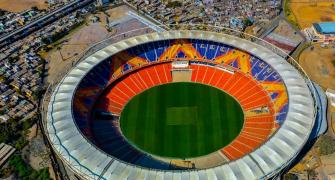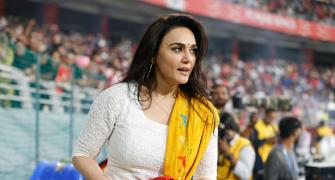With a decelerating economy that weakens India's hands on geopolitical issues, it will be interesting to know which way this trip will go, notes T R Vivek.

While it wasn't an official visit, the first occupant of the White House to land on the shores of India was Ulysses S Grant, and likely not the last with, let's say a dodgy sense of aesthetics.
The 18th president of the United States, Grant, served two consecutive terms in office between 1869 and 1877 and was also the commanding general of the US army when the American civil war was won. Soon after his term ended, Grant and his wife Julia set forth on a two-and-a-half-year world tour that aimed to project the US as an outward looking power ready to engage with the world.
Grant arrived in Bombay in February 1879 aboard the USS Richmond and undertook the customary trip, on elephant back, to the Taj Mahal in Agra, whereupon the Grants thought it beautiful but not more than the Capitol Hill building.
Grant met Viceroy Robert Lytton in Calcutta and professed admiration for his father Edward Bulwer-Lytton's novels. In 1982, the San Jose State University instituted the annual, tongue-in-cheek Bulwer-Lytton Fiction Contest to award the worst possible opening lines of a novel as a tribute to Bulwer-Lytton's 'It was a dark stormy night' in his 1830 work Paul Clifford.
It remains to be seen what reluctant traveller Donald J Trump, the 45th president of the US on his two-day visit between February 24-25 makes of the spartan Sabarmati Ashram, the Taj Mahal, or the Namaste Trump rally in Ahmedabad where Prime Minister Narendra Damodardas Modi assures there would be 'millions and millions' in attendance.
Beyond the bear hugs and protestations of a great personal bond between the two leaders, this visit carries a more transactional flavour than other recent presidential trips to India. Unlike in the past, a trade deal between the two occupies centerstage, given the context of Trump's domestic policy priorities.
Trump, the self-professed master of deal making has in recent months dubbed India 'tariff king' in a tweet pointing towards India's propensity to heavily tax US exports such as high-end Harley Davidson motorcycles.
India, instinctively wary of trade deals, now has more reason to worry considering the deteriorating health of the export sector after sector from gems and jewellery to textiles. India's inability to take any meaningful advantage in return for greater American access to its domestic markets perhaps explains its lack of enthusiasm on this front.
But hey, we're at least talking business. It wasn't like this always.

The first-ever visit of a serving US president took 12 years in the making since India's independence. Dwight D Eisenhower, a decorated war hero, was welcomed in India as a 'Prince of Peace'. The week-long visit was a big success with Eisenhower travelling in an open car with thousands lining the streets.
Despite India fronting the distinctly anti-West Non-Aligned Movement, Nehru, the romantic statesman and Eisenhower, the soldier, seemed to have hit it off.
Just as Modi might personally show Trump around the Sabarmati Ashram, Nehru in 1959 offered the Eisenhowers a guided tour of the Taj. Eisenhower was lavish in his praise for India from the get-go. 'In fulfilling a desire of many years, I pay in person America's tribute to the Indian people, to their culture, to their progress and to their strength among independent nations,' he declared on arrival, adding that it was a personal pilgrimage of sorts.
Not only that, in his address to a special joint session of parliament, Eisenhower spoke about American support to India in the face of any external acts of aggression.
It could be that the two had cultivated more than an acquaintance when Nehru was conferred an honorary doctorate by Columbia University in 1949 when Eisenhower was its president. But matters of commerce hardly figured.
Perhaps knowing Nehru's not-so-charitable views on American wealth, there was no business delegation that accompanied Eisenhower -- something that is an essential part of bilateral head of State visits in the 21st century.
In the rising heat of the Cold War the bonhomie quickly evaporated. Nehru's reciprocal visit to the US in 1961 during John F Kennedy's presidency was a testy affair given India's embrace of the Soviet Union.

Richard Nixon's visit a decade after Eisenhower could charitably be described a disaster. It was more a 22-hour stopover than a full-fledged State visit. You only need to scan The New York Times pages on the eve of Nixon's visit to get a sense of its lack of purpose.
So wide was the gulf of distrust between the two nations, and India's inconsequence in the larger scheme of things that none of the issues you'd normally expect -- South Asian regional stability, the India-Pakistan arms race, unrest in East Pakistan or the Chinese threat -- made the headlines. The touring party was more worried about droppings from Delhi's trees.
'If Mr Nixon rides under clear skies with the top of his bubblecar down, he will have to beware the fallout from Delhi's ubiquitous Jamun trees. Their purplish bounty, a semi-sour cherry like fruit with a big, hard pit, splatters indiscriminately on heads of passersby these days,' noted the NYT.
Not many were surprised when declassified US papers showed the contempt Nixon had for then prime minister Indira Gandhi. The sentiment was certainly mutual.
A year later, she returned the favour by not attending Nixon's banquet for heads of State on the sidelines on the United Nations's 25th anniversary celebrations.
Jimmy Carter's visit in 1978 too wasn't any more memorable than Nixon's. Carter said he loved reading the Bhagwat Gita presented to him by then prime minister Morarji Desai. Carter, in return, offered Desai the two-volume journal of American writer Henry Thoreau.
From 1947 to 2000, there had only been three US presidential visits to India. Since 2000, counting Trump's, there would be five.
It was perhaps an acknowledgement of India's growing economic and strategic importance for the US. While Bill Clinton charmed Indians in 2000 in the backdrop of the Kargil war and signalled the end to post-Pokhran nuclear test sanctions, substantive gains were made during George W Bush's visit in 2006 with signing of the landmark civilian nuclear deal.

Barack Obama is the only US president to make two State visits to India in 2010 and 2015. The second, a hastily arranged special invitation as chief guest on Republic Day.
In 2010, with Manmohan Singh as PM, who Obama had referred to as a 'Global Guru' at a G20 Summit for his leadership in defusing the global financial crisis, the expectations were understandably high. Both had a reputation of being cerebral.
While Obama's celebrity quotient having become the first African-American president with a landslide win was at its peak, Singh too had won a second term in office with a bigger mandate for the Congress party. The gush of warmth seemed unstoppable.
If Clinton de-hyphenated India and Pakistan, Bush invested plenty of personal political capital on getting the nuclear deal through, Obama followed the path of his predecessors with greater vigour. At least that's what it looked back in 2010. Moreover, in his address to the joint session of Parliament, Obama publicly endorsed India's candidacy for a permanent seat in the UN Security Council -- the first US president to do so.
- Clinton in India, March 2000
- Bush in India, March 2006
- Obama in India, November 2010
- Obama in India, January 2015
By 2015, the Modi bear hug had well and truly arrived on the international diplomatic arena and Obama was one its early recipients. There was to be no parliamentary address during this short visit, but enough time for the man derided as chaiwala to personally make a cup of tea over a televised tete-a-tete on the lawns of the PM's residence. The infamous monogrammed Modi suit too made an appearance during that visit.
Pomp, pageantry and symbolism trumped over substance.
With a decelerating economy that weakens India's hands on geopolitical issues, would Trump's visit too go down that route?
Maybe, just maybe, unlike the Grants, Melania and Donald Trump might think the Taj more beautiful than Trump Towers. One wouldn't bet on it, though.
T R Vivek is a journalist based in Bengaluru. @trvivek











